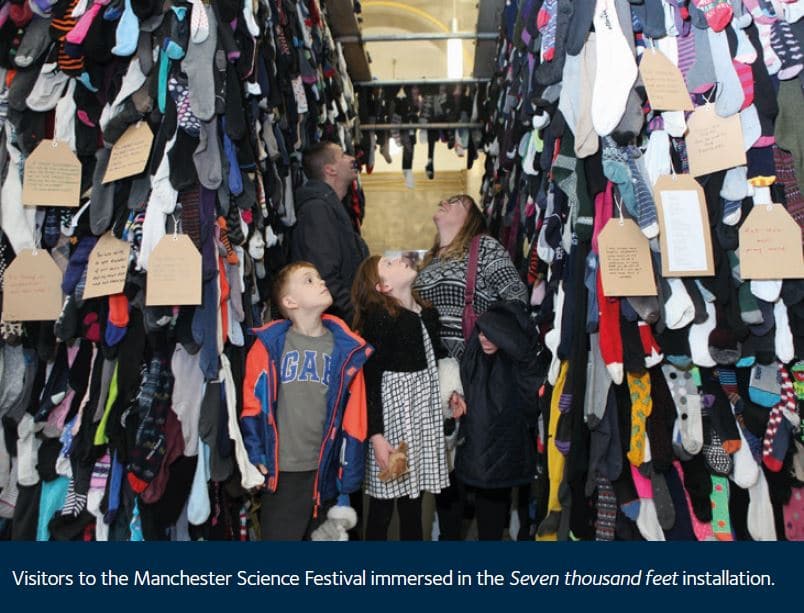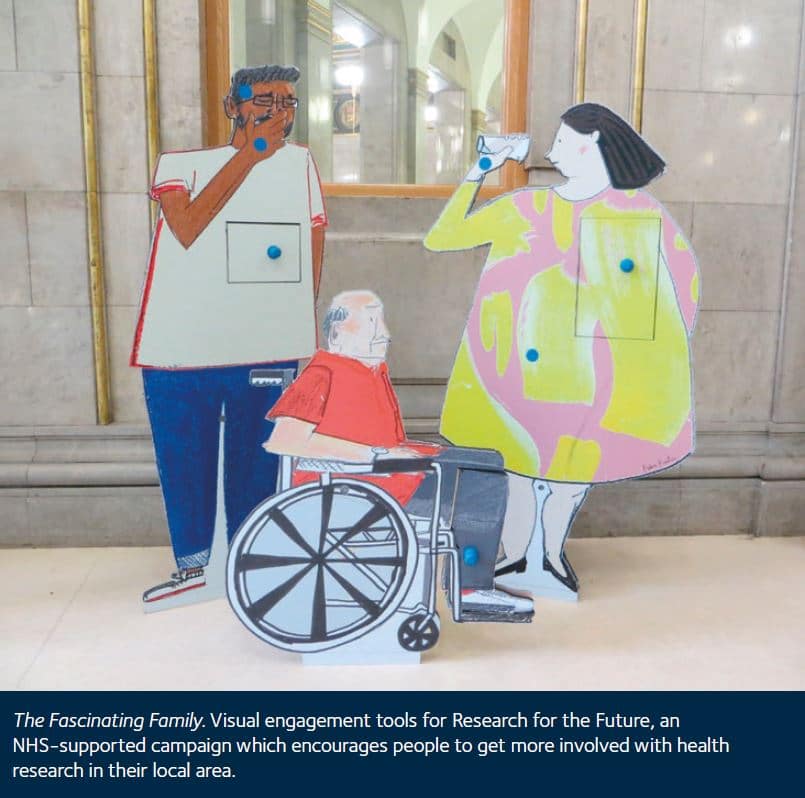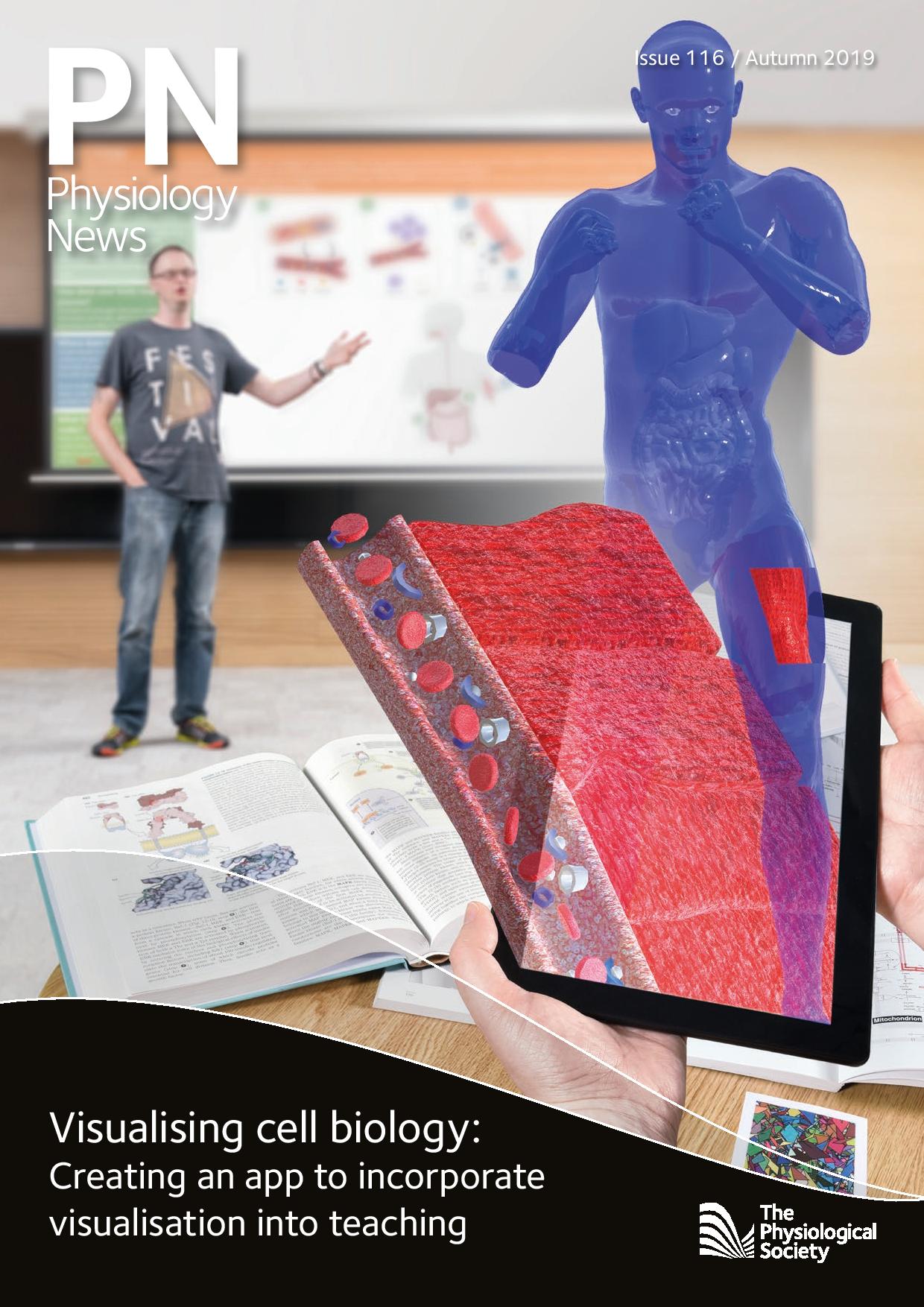
Physiology News Magazine
Art and science together can change the world: Seven Thousand Feet and The Fascinating Family
Membership
Art and science together can change the world: Seven Thousand Feet and The Fascinating Family
Membership
Christine Wilcox-Baker, Lead artist and organiser, Seven Thousand Feet exhibition
https://doi.org/10.36866/pn.116.44
My maternal grandmother had type 2 diabetes; I didn’t know much about this disease and wanted to find out more. Will my mother develop it? Will I? I’ve been a visual artist for many years, and completed a Masters in Art as Environment in 2008 at Manchester Metropolitan University (MMU). A few years ago, I felt a new urge to do something “useful” with my artwork. I met Martin Rutter, Professor of Cardiometabolic Medicine at the University of Manchester and Honorary Consultant Physician at Manchester Diabetes Centre, who became my mentor.
We had an initial discussion about the potential merits of trying to use visual art to portray messages, about diabetes, to the general public in ways different from the usual health education routes. Martin and I then had a number of meetings and discussed aspects of the condition. We identified a need to try new ways of bringing this information to the general public and encourage them to take this condition seriously.
As he put it, “It has to be worth a try… more people are developing the condition and current health information routes are not working well enough.” The project takes its title, Seven Thousand Feet, from the approximate number of diabetes-related lower limb amputations performed in the UK each year at that time. The scale of the problem was made clear by the fact that by the time of the exhibition the figure had risen to 8,793 amputations per year. I had been very shocked by this statistic and it kept coming back to me, hence choosing it as the title.

Martin then introduced me to a number of other health practitioners who also thought this was a good idea to pursue. These expert practitioners, who also supported the project, agreed that traditional health education has a role but it is not reaching everyone. Using creative interventions is a new way to engage on the topic of diabetes. It adds a different dimension to information already out there.
From a little idea the project started to grow. I met diabetes dietitians, nurses, researchers, medics and an impact and engagement manager (Edwin Colyer), from both the University of Manchester and MMU, along with Newcastle University. Everyone I met immediately “got on board” and I have had a huge amount of support from these people for which I am immensely grateful.
I subsequently developed a portfolio of proposed artworks and interactive events, informed by and in collaboration with them. Some ideas involved animation and illustration and I wanted to involve other artists and students in order to add to the variety of visuals and have different age groups’ interpretations. With this plan in mind I contacted MMU’s Illustration with animation course leaders. They too welcomed the project and put it out to their students as a “live” project. Four BA students, three BA graduates and two MA graduates took up the challenge and tutor Eleanor Mulhearn took the lead.
Working with Katherine Grady, Programme Development Manager at Research for the Future, the Salford-based organisation who supply participants to numerous diabetes research projects, I wanted to create a visual “family” as tools for their public engagement events. Also working closely with Neil Reeves and Gladys Pearson, from MMU, I successfully applied for a grant from The Physiological Society.
I thought that the figures should be contemporary-styled 21st century images but, for me, they were also inspired by the 18th century anatomical wax figures I have extensively researched at the Josephinum in Vienna and the Museo Delle Cere Anatomiche in Bologna. I also had the privilege to spend a day in an operating theatre at Manchester Royal Infirmary where I observed operations to remove calcium deposits from main arteries. These procedures, aimed at reducing the risk of amputation, were carried out by Naseer Ahmad, Consultant Vascular surgeon, and his team. This experience helped me with the concept and in particular for one of the figures – “Jack” who has had one leg amputated and has blocked veins and ulcers on his other leg.

I pulled everything together and the concept for The Fascinating Family was born. The plan was to have a “family” of three free-standing cut-out figures who could show us some of the symptoms and outcomes of diabetes. We wanted the figures to be interactive, so we installed motion sensors that would start playing the voice recordings. Each figure tells a story of their experiences of diabetes and also has a series of “blue dots” which represent symptoms and outcomes. One blue dot on each figure acts as a door knob and reveals further potential outcomes. I commissioned MMU student Fabia Fowler to do the illustrations in her fabulously engaging style.
Seven Thousand Feet is a collection of visual art informed by diabetes. The central installation for the exhibition comprised 7,000 individual socks, representing the aforementioned UK annual diabetes-related amputation statistic. The individual socks were stitched onto mesh panels by an army of volunteers. The panels were then fixed to a scaffolding frame. Other exhibits included illustrations, animations, a card game, silk scarf, artist book, sculptures and interactive pieces. Many were created by MMU students and graduates and images of all pieces can be found on the project website. Clothes in bespoke fabrics adorned mannequins and portrayed patterns with “traffic light” backgrounds showing illustrations of healthy (green), not so healthy (amber) and very unhealthy (red) diets.
The exhibition gained a large amount of coverage in the press, on social media, websites and on TV. We had been working with Diabetes UK during the planning and research and they were immensely helpful and supportive. Following the success of the Manchester exhibition, Diabetes UK asked if we could bring the exhibition to their Professional Conference in March 2019. This took place at the Liverpool Arena and Conference Centre and attracted over 3,000 delegates. This was an opportunity that was too good to miss and, despite having no funding left, we decided we had to be there. We received amazing responses from delegates; as one of them put it “you’re all over social media.”
We’d thought along the way that The Fascinating Family could perhaps be a prototype for other “families” who could illustrate other health conditions and would be delighted to talk to anyone who may be interested. Also many of our artworks are available to those involved with diabetes and we have produced a website to show the work (google.com/view/seven-thousand-feet/home). Images can be used in presentations and publications too – please don’t hesitate to get in touch via the project website or my website axisweb.org/p/christinewilcoxbaker or via the websites listed.
Responses from our various events tell us that many visitors, including some already diagnosed with diabetes, learned a lot from our endeavours, found the use of visual art powerful and want to make some lifestyle changes. Some of the comments included: “it made me decide to eat healthier as I have a family history of diabetes and I am borderline”; “I definitely need to reduce my sugar intake as I eat a lot and did not realise the impact diabetes could have”; “your info has been a reawakening of my need to be aware”; “7,000 socks – what a brilliant concept to get a very important message across.”
I’ve learnt a lot too, including ways to minimise my own risk of diabetes by watching my diet and keeping active and that it isn’t a given that you’ll develop it because it is in your family. Looking ahead to the future, I’m very interested in working on other health-related projects though I might perhaps let others share the lead in future! The whole project has been a fantastic (if exhausting) experience and I have met many amazing people along the way. I am extremely grateful to all those who participated; attended the exhibition, conference and events; the crowdfunders, volunteers and supporters; and particularly to The Physiological Society for being midwife to The Fascinating Family.
